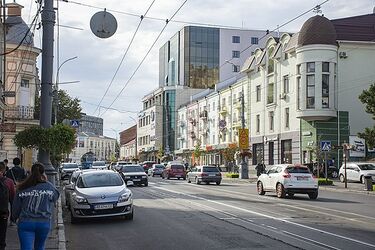Vinnytsia, Ukraine
Vinnytsia, Ukraine is a city of 370,601 in the historical Podolia region of west-central Ukraine, on the banks of the Pivdennyi Buh river and about 150 miles southwest of Kyiv. It is the administrative center of the Vinnytsia Oblast, and also an industrial center and the headquarters city of the Ukrainian Air Force. The current mayor is Serhii Morhunov.
The city's name, which translates as "bride price" in Old Slavic, appeared in the historical record in 1363, in reference to the purchase of the surrounding district by Duke Algirdas of Lithuania as a gift for his nephews. One of those, Fiodor Koriatowicz, was granted the site of the future city and erected a fortress there in 1363 to defend it against Tatar raiders. During the reign of Algirdas' son Švitrigaila, leadership of the fort was given to Aleksander Hrehorovicz Jelec was as hetman and starosta. Jelec saw the settlement grow into a town, which was granted rights under Madgeburg Law by Grand Duke Alexander Jagiellon in the 1490s. The town was part of the Bracław Voivodeship, established in 1566 under the Polish–Lithuanian Commonwealth, and passed to the Polish crown in 1569. Between 1672 and 1699 it was officially ruled from Constantinople as a protectorate of the Ottoman Empire, but was still tied to the Polish crown as a royal city.
Antoni Protazy Potocki established the Kompania Handlowa Polska, also known as the Black Sea Trade Company, in Vinnytsia in 1783. The company operated a merchant fleet along the busy route between Russia and the west until its fleet was seized by the Russian Empire during the Russo-Turkish War of the 1790s. In 1793 Russia took possession of Vinnytsia as part of the Second Partition of Poland. The city's Catholic churches, including the Transfiguration Cathedral of 1758, were converted to Orthodox worship.
Vinnytsia remained part of Russian Republic immediately after the abdication of Tsar Nicholas II in 1917, but was part of the territory that was disputed during the Ukrainian War of Independence, and briefly hosted the directorate of the Ukrainian People's Republic after Bolshevik forces captured Kyiv in 1919. Facing defeat, the UNR allied with Poland, but Mikhail Tukhachevsky's Red Army swept over Ukraine and forced a treaty with Poland that cemented Vinnytsia in the Ukrainian Soviet Socialist Republic, part of the USSR.
In 1937 and 1938, during the "Great Purge" led by Soviet General Secretary Joseph Stalin, the People's Commissariat for Internal Affairs (NKVD) as many as 20,000 people in the region of Vinnytsia in mass executions. Those targeted included Polish speakers and "bourgeois nationalists" who criticized the Soviet government.
During World War II Vinnytsia was occupied by German forces. The Germans erected a monument to the victims of Stalin's purge and promoted a narrative that Jews had been responsible for those deaths. A Nazi military headquarters, "Führerhauptquartier Werwolf" was built by prisoners of war in the forest just north of the city. Schutzstaffel commanders at the complex oversaw the activity of Einsatzgruppen, which were responsible for the murder and deportation of Jewish citizens, including the destruction of Vinnytsia's Yerusalimka neighborhood. Adolf Hitler himself spent several weeks at Werwolf in late 1942 and early 1943. The site was destroyed by Nazi forces as the Red Army advanced across the region in March 1944. A photograph depicting the murder of a man kneeling before a mass grave was found among the belongings of a German soldier, with the title "Der letzte Jude in Winniza" ("The last Jew in Vinnytsia") written on the back. The photograph has become an iconic image of the holocaust and was controversially used in 1984 as the cover of an album by the punk group Agnostic Front.
After the war, Russia established a major air base at Vinnytsia, which became the home base of its 43rd Rocket Army and the 2nd Independent Heavy Bomber Aviation Corps in 1960. After the dissolution of the Soviet Union in 1991 the base became the headquarters of the Ukrainian Air Force.
Among the major industries operating in Vinnytsia are small arms manufacturer RPC Fort, and the Roshen confectionary corporation, a conglomerate founded by Petro Poroshenko, who served as President of Ukraine from 2014 to 2019. The city also houses manufacturing plants for the Analog Music Company, Mayak boilers and machinery, Budmash industrial equipment, and PlasmaTec welding equipment.
The city's main park is the 98-acre Leontovych Central Park, formerly named for Maxim Gorky. Among the city's many universities is the Donetsk National University, which relocated to Vinnytsia during the 2014 War in Donbas.
On April 23, 2003 Vinnytsia and Birmingham forged a "sister city" relationship, at the invitation of the United States Agency for International Development. A separate arrangement dating to 1999 twinned Birmingham with the smaller Ukrainian town of Krasnodon as "Friendship Cities". The Birmingham Sister Cities Commission has organized several delegations and exchanges with Ukrainian peers. Board member Scotty Colson has served as Alabama's Honorary Consul to Ukraine.
During the 2014 Donbas War Birmingham coordinated humanitarian shipments of medical supplies to Ukraine. Similar efforts accompanied Russia's 2022 invasion of Ukraine. The Havryshivka Vinnytsia International Airport was targeted by several Russian missiles on March 6.
References
- Hrynkiw, Ivana (February 24, 2022) "How is Birmingham connected to Ukraine?" The Birmingham News
- Flanagan, Ben (March 6, 2022) "Russian missiles strike Birmingham sister city, Zelensky says." The Birmingham News
